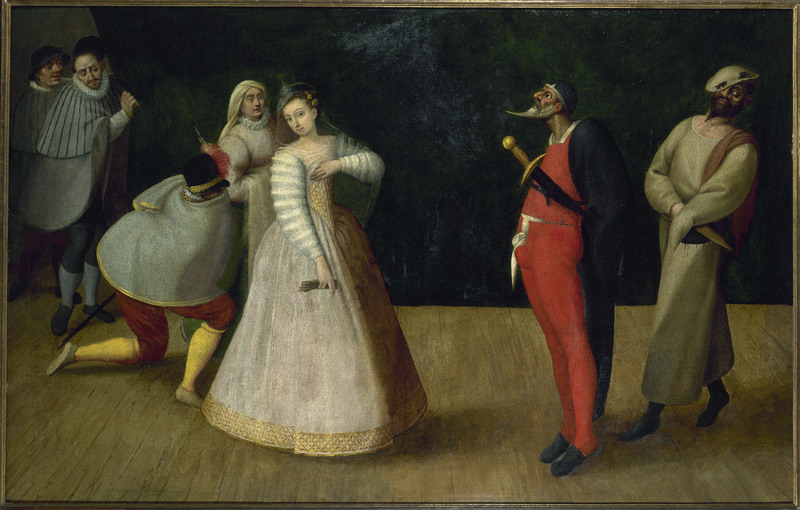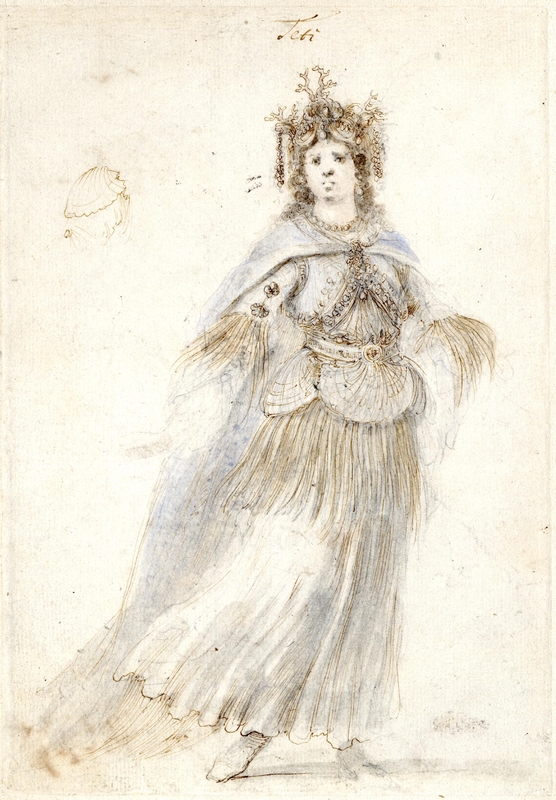Sixteenth Century Celebrities: Prima Donnas in Italian Commedia dell'Arte
The Origins of La Prima Donna
The prima donna as a public persona first rose in popularity on the sixteenth-century stages of commedia dell’arte in Italy, where prima donnas emerged not as opera singers but instead as actresses in the performing art that catered to the general public through a stock cast of characters with comedic elements. Troupes like I Gelosi achieved wide acclaim as Isabella Andreini rose to fame as its leading lady.
Painted below, the c. 1580 oil painting Commedia dell’arte troupe (I Gelosi?) most likely depicts the troupe performing a scene from the genre on a stage, featuring stock characters like the mischievous Brighella and Il Capitano. Andreini is believed to be the central woman figure, wearing a white gown with golden detailing that highlights her in comparison to the rest of the troupe. While every other actor looks up or to the side positioned in profile positions, Andreini is almost completely turned out to the audience while looking at her viewers directly, signaling her renown in the performing art and the connections that her fans and audiences felt with her.
Actresses like Andreini were some of the first to assume the prima donna persona to mass praise, achieving an early celebrity status in rare opportunities for women to work publicly. Indeed, scholars like Rosalind Kerr have described that audiences imagined themselves as closer to their prima donnas than they actually were. The public also gossiped about early rivalries between prima donnas, where fans created rivalries between stars like Vincenza Armani and Flaminia of Rome, pitting one against the other.
The Rise of the Opera
These icons of commedia dell’arte paved the way for the prima donna persona within opera, which developed in Italy around the early seventeenth century. Early opera often focused on telling dramatic and classical stories with arias and a chorus. Moreover, the performing art featured a heavily stylized vocal style with aspects like coloratura, the use of vocal runs, note leaps, and other showcases of vocal agility.
Cavalli’s L’Hipermestra was one such opera. Premiering in 1658 and based on the Greek tale of the woman of the same name, the opera featured costume designs from creators like Stefano della Bella. His design for the character of Thetis can be viewed below, complete with ornamental and lavish decorations that reflected the background of the character’s origins as a sea goddess.
Shaded with light blue, golden, and white hues, della Bella’s drawing on paper includes reflective choices including scallop-shells and a head-piece made of coral and shell. The work is also indicative of his subtle sketching style, with a use of minimal and muted coloring along with fine lines that highlight the smaller, intricate details of the costumes that he drew, such as Thetis’s necklace of easily identifiable pearls.

